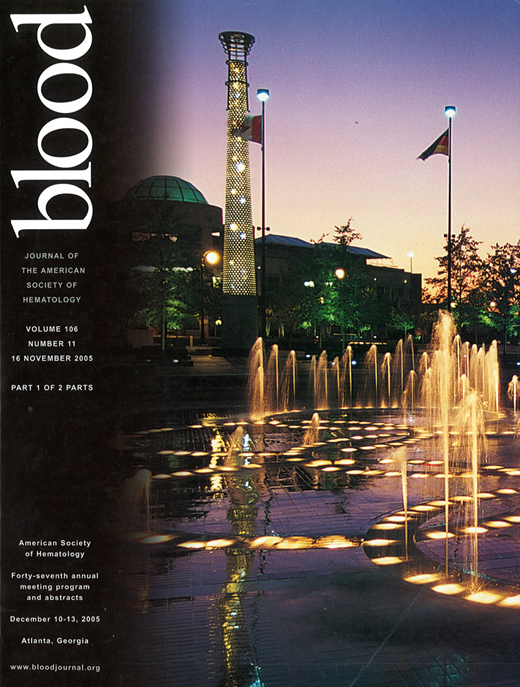Abstract
The Rho family GTPase Cdc42 has emerged as a key signaling molecule with unique roles in multiple hematopoietic cell lineages. To investigate the physiologic role of Cdc42 in hematopoietic stem cells/progenitors (HSC/Ps), we bred conditional cdc42flox/floxmice with Mx-Cre mice that allowed interferon-inducible cdc42 deletion in hematopoietic cells in vivo following polyI:C induction. Loss of Cdc42 expression in the bone marrow caused significant leukocytosis with neutrophilia in peripheral blood (PB) (Table). Concurrently, deletion of cdc42 in the bone marrow led to a massive efflux of HSC/Ps from bone marrow to PB, liver and spleen (Table) and increased proliferative activity of HSC/Ps. Consequently, flow analysis further revealed that the number of Lin-Sca-1+c-Kit+ (LSK) HSCs in BM, PB, spleen and liver increased significantly following cdc42 deletion (Table). Transplantation of the cdc42−/− bone marrow cells into NOD/SCID recipient mice or competitive transplantation into BoyJ recipient mice showed that cdc42 deficiency in the bone marrow caused the impaired engraftment (Table) and the failure of hematopoiesis after a transient increase of cell cycle rate of HSCs. The engraftment defect is associated with a homing deficiency (Table). The cdc42−/− (Lin−c-Kit+) HSC/Ps showed defects in cortical F-actin assembly, adhesion to fibronectin and directional migration in response to SDF-1α (Table). These data suggest that defective actin structure and adhesion of the cdc42−/− HSC/Ps may contribute to the loss of retention of the cells in the BM niche and to the mobilization phenotype. Moreover, deletion of cdc42 resulted in significantly reduced thymus cellularity, T cell, B cell population, and decreased Ter119+ cell number associated with markedly decreased CFU-E activity of the bone marrow cells (Table). Two additional complimentary approaches, BM-reconstitution by cdc42−/− HSCs and reciprocal (rescue) transplantation by WT HSCs, further demonstrated that the Cdc42 loss-of-function phenotypes are hematopoietic cell intrinsic. Taken together these results implicate Cdc42 as a critical regulator of HSC mobilization, homing and engraftment, and indicate that Cdc42 is involved in erythropoiesis and in T- and B-cell differentiation and homeostasis.
| . | WT . | Cdc42−/− . |
|---|---|---|
| *p<0.05**p<0.005†p<0.001 | ||
| White blood cell count, × 109 /L | 11.0±2.5 | 40.8±3.9† |
| Neutrophil count, × 109 /L | 4.6±0.8 | 34.1±4.7† |
| CFU-C per 105 liver cells | 0.13±0.12 | 169±132* |
| CFU-C per 104 spleen cells | 1.36±1.05 | 68.4±55.6** |
| CFU-C per 100μl PB | 3.67±2 | 58.8±47.3** |
| LSK HSCs in BM | 0.52%±0.22% | 0.94%±0.45%* |
| LSK HSCs in PB | 0.13%±0.08% | 0.31%±0.15%* |
| LSK HSCs in spleen | 0.37%±0.20% | 0.63%±0.23%* |
| LSK HSCs in liver | 0.23%±0.10% | 0.70%±0.18%* |
| Engraftment in NOD/SCID mice | 35.0%±4.9% | 23.0%±7.1%* |
| Competitive transplantation | 61.5%±6.7% | 22.2%±2.9%** |
| CFU-C Homing to BM (% injected) | 0.85%± 0.11% | 0.28%± 0.12%** |
| Adhesion to fibronectin (%plating) | 50.8%±2.5% | 28.8%±4.0%** |
| Migration to SDF (%input) | 26.2%±5.3% | 5.4%±0.9%† |
| CD3+ T cells in BM | 5.4%±0.22% | 2.7%±0.45%** |
| B220+ B cells in BM | 8.4%±4.6% | 1.5%±2.0%† |
| Ter119+ cells in BM | 15.2%±9.3% | 6.0%±4.2%* |
| CFU-E per 105 BM cells | 87.8±9.7 | 25.6±4.2† |
| . | WT . | Cdc42−/− . |
|---|---|---|
| *p<0.05**p<0.005†p<0.001 | ||
| White blood cell count, × 109 /L | 11.0±2.5 | 40.8±3.9† |
| Neutrophil count, × 109 /L | 4.6±0.8 | 34.1±4.7† |
| CFU-C per 105 liver cells | 0.13±0.12 | 169±132* |
| CFU-C per 104 spleen cells | 1.36±1.05 | 68.4±55.6** |
| CFU-C per 100μl PB | 3.67±2 | 58.8±47.3** |
| LSK HSCs in BM | 0.52%±0.22% | 0.94%±0.45%* |
| LSK HSCs in PB | 0.13%±0.08% | 0.31%±0.15%* |
| LSK HSCs in spleen | 0.37%±0.20% | 0.63%±0.23%* |
| LSK HSCs in liver | 0.23%±0.10% | 0.70%±0.18%* |
| Engraftment in NOD/SCID mice | 35.0%±4.9% | 23.0%±7.1%* |
| Competitive transplantation | 61.5%±6.7% | 22.2%±2.9%** |
| CFU-C Homing to BM (% injected) | 0.85%± 0.11% | 0.28%± 0.12%** |
| Adhesion to fibronectin (%plating) | 50.8%±2.5% | 28.8%±4.0%** |
| Migration to SDF (%input) | 26.2%±5.3% | 5.4%±0.9%† |
| CD3+ T cells in BM | 5.4%±0.22% | 2.7%±0.45%** |
| B220+ B cells in BM | 8.4%±4.6% | 1.5%±2.0%† |
| Ter119+ cells in BM | 15.2%±9.3% | 6.0%±4.2%* |
| CFU-E per 105 BM cells | 87.8±9.7 | 25.6±4.2† |
Author notes
Corresponding author

